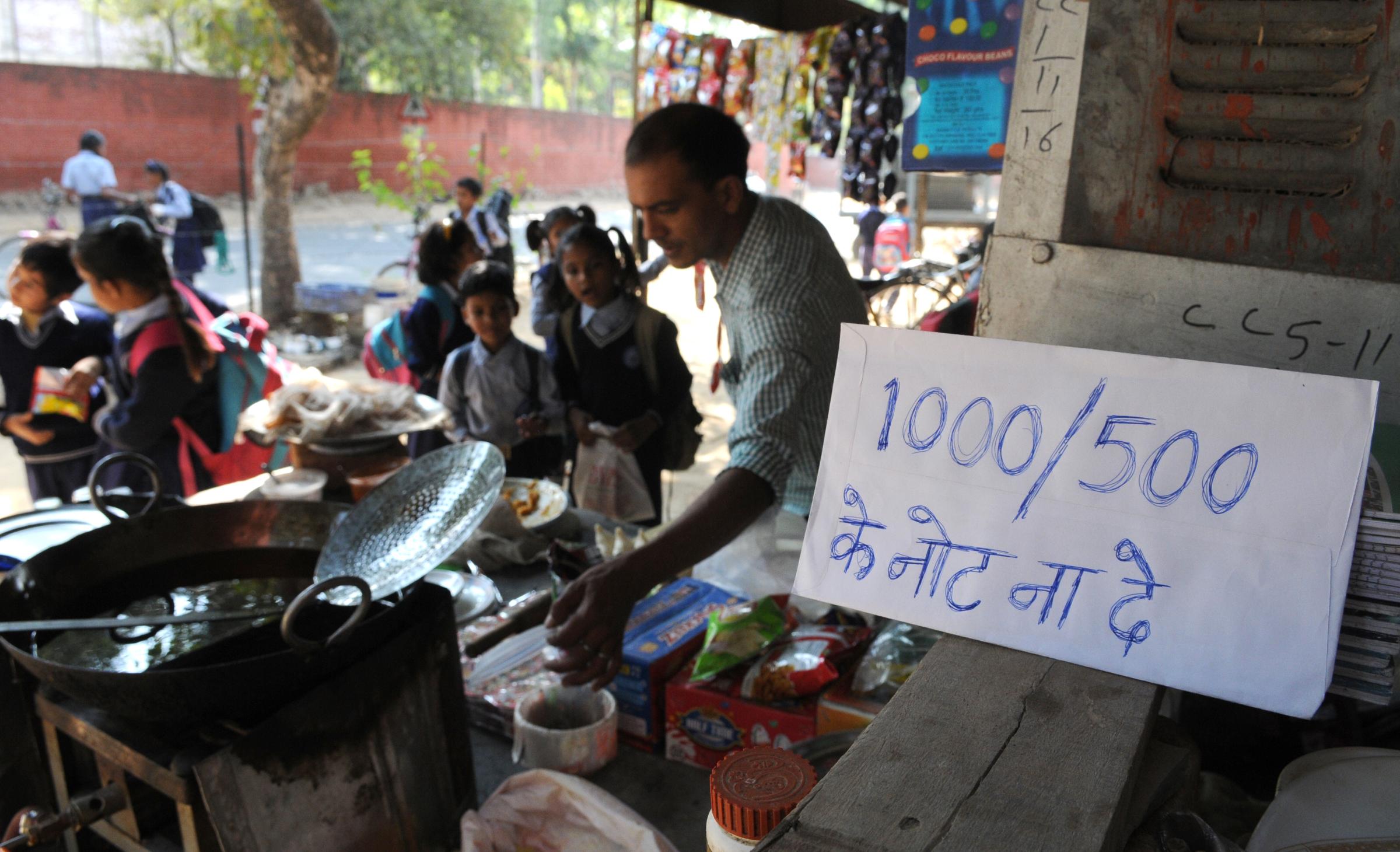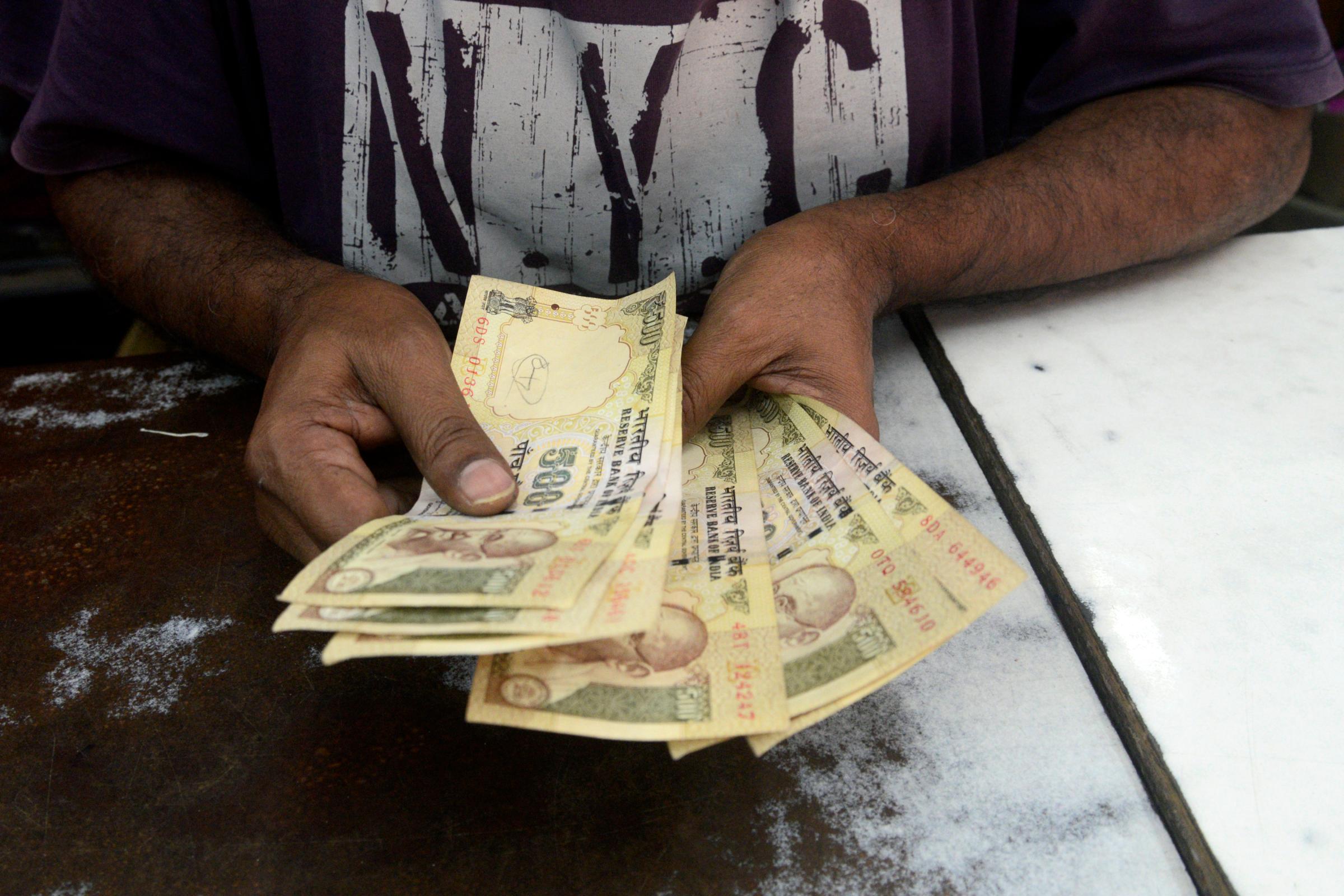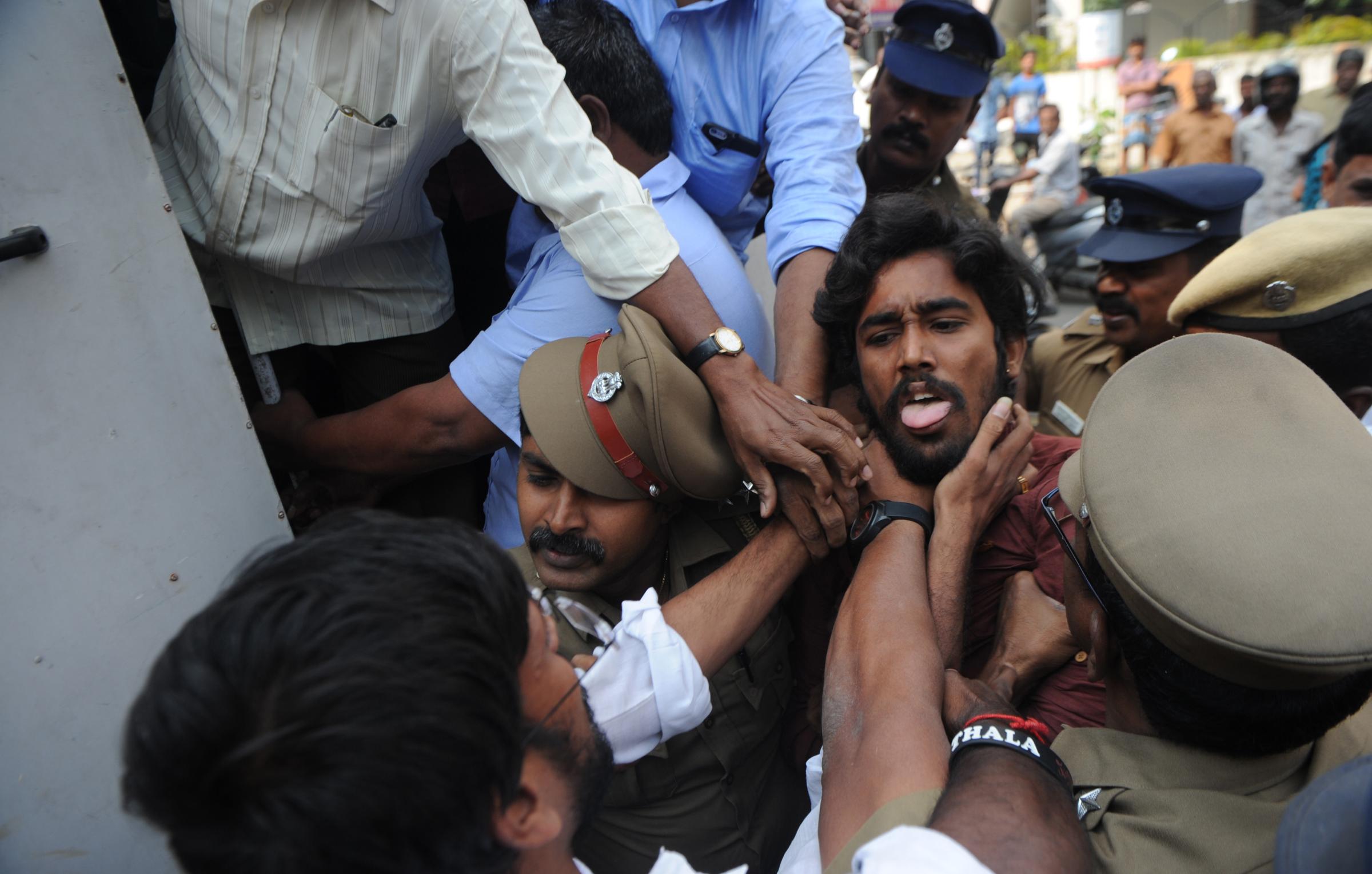“It was like someone had picked my pocket,” says Prashuram, a 52-year-old casual laborer in the Indian capital New Delhi, recalling the evening of Nov. 8.
The day had begun well. The onset of north India’s traditional wedding season had brought a steady stream of work for Prashuram and his 33-year-old friend Hari. Migrants from nearby Indian states, the two spent the day working a series of odd jobs for a busy wedding caterer. For a dawn to dusk stint, they pocketed 500 rupees (about $7.5) each. That is typical in India’s vast informal economy, which employs more than 90% of the country’s workforce. Agreements here are verbal, the pay very often in cash and workers tend to have few, if any, guarantees or benefits. They also earn less than their compatriots in what is called the formal sector, where salaries are taxed, the work more regular and the average pay is more than twenty times higher.
Prashuram and Hari were each paid in a 500 rupee note. “It was always 500 or maybe a 1,000 rupee note for two days work,” says Prashuram.
After collecting their dues, the two friends went to a food stall near a Delhi night shelter they call home. It was there, just as Parshuram was about to start digging into his meal of lentil curry and chapattis, that the stall owner asked him how he intended to pay for his dinner.
“I was surprised. We’re regulars there. The lentils cost 25 rupees (30 cents), and the chapattis are 2.5 rupees (3 cents) each. But because he asked, I showed him a 500 note, the one I’d received from the caterer,” says Parshuram. “He said he didn’t want it.”
The stall owner he said he would only accept 100, 50 or other, smaller rupee bills. “We didn’t understand what the stall owner was saying,” explains Prashuram. “We hadn’t heard Modi’s speech.”
Prashuram and Hari were just finishing their shifts when India’s Prime Minister Narendra Modi made an unscheduled national address, interrupting local news broadcasts about the U.S. presidential contest. As Americans went to the polls and India’s talking heads were busy speculating about how the results might impact ties between the two countries, Modi suddenly began speaking from New Delhi. What he said shocked the nation — and left Parshuram and Hari with empty stomachs.

“To break the grip of corruption and black money, we have decided that the 500 and 1,000 currency notes presently in use will no longer be legal tender from midnight tonight, that is Nov. 8 2016,” Modi announced. “This means that these notes will not be acceptable for transactions from midnight onwards.”
It was a stunning move. At the moment Modi banned them, the two bills accounted for roughly 86% of all cash in circulation, meaning that many Indians besides Parshuram and Hari went hungry. Plastic isn’t an option for the vast majority. Most small businesses, such as restaurants or grocery stores, do not accept credit or debit cards. Not that it would have helped: Parshuram is like an estimated 90% or more of Indians in that he relies exclusively on cash. And his friend is among the roughly 233 million Indians who did not even have bank accounts, let alone credit or debit cards.
“All business, all industry, whether white or black, requires cash. When you [remove] such a large percentage of the cash, it’s like from a patient you’ve taken out [86%] of the blood,” says Arun Kumar, a Delhi-based economist and author of The Black Economy in India, an account of the shadowy swathes of Indian economy where wealth goes untaxed, and where the corrupt and the criminal operate.
To help the government catch tax evaders and other hoarders of illicit money, Modi said Indians would have to go to the bank to disclose all their cash. They had two options. Until the end of the year, they could either exchange small amounts of old notes for a redesigned 500 and a new 2,000 rupee bill, or deposit their funds and then withdraw set amounts from ATMs. From January, the only option would be to go to the country’s central bank to make deposits, a facility that would expire in March, Modi said. Big deposits would be scrutinized by tax authorities, driving those with large stocks of ill-gotten banknotes into a corner. They could either come clean, or be forced to destroy their dirty money.
That, at least, was the theory. “The problem is that only a small proportion of black wealth is stored in cash,” says Kumar. Estimates vary, but he puts the figure of illicit wealth stored in cash at around just 1 or 2% of the total black wealth in the country. The criminal and the corrupt seldom hold on to cash, he says. Instead of stuffing their mattresses, they purchase property or gold, or move their funds abroad. “They find ways to put their money in the stock market, mutual funds or other places. Most black wealth isn’t in cash,” he explains.
Swati Dhingra, an economist at the London School of Economics (LSE), agrees: “This is essentially just targeting petty corruption. You clearly don’t hold cash if you’re super rich. You go buy property, you have a Swiss bank account.”

Any impact, says Kumar, is likely to be temporary. “This targets some stocks of black wealth that are in cash, not the mechanisms that generate black income in the first place. Next year, you’ll still generate the same amount of black income. So it’s not achieving the purpose of stopping the growth of the black economy.”
The suddenness of the move, with Indians given just a few hours notice before the cash ban, raised another, more pressing question: would the fallout be worth it in what is a cash-based economy? Shortly after Modi’s speech, Parshuram and Hari were forced to beg for credit at the stall to finish their meals. “It was before midnight. But the stall owner refused to take any 500 or 1000 rupee notes from anyone,” says Parshuram. With his announcement, Modi had made the notes “jaali,” he adds, using the Hindi word for fake. The stall owner refused to budge. “He wanted smaller notes. I had money, but it was of no use.”
Much worse was to follow when the government bungled the currency swap, sharpening concerns about the potential economic fallout. Officials insist that they have enough new currency available to replace the banned notes. But across India, ordinary citizens have been struggling to get their hands on the new cash, with long queues forming outside banks and ATMs up and down the country. The picture is the same at many post offices where cash can be deposited and exchanged.
Many ATM machines simply aren’t working, and when they are, often run out of cash within hours of replenishing. And in the days after Modi’s speech, it emerged that the new replacement bank notes were of a different size to the old ones, meaning country’s roughly 200,000 ATMs will need to be reconfigured. (The government says it could not have made the changes public beforehand, as the cash swap plans had to be kept secret to avoid giving those with illicit funds the time to launder their cash hoards.)
Read More: Bank Queues Across India Swell as Millions Rush to Exchange Old Currency Notes
There are other hurdles, borne of longer-term gaps in India’s financial infrastructure. Take the spread of bank branches across urban and rural areas, where the majority of Indians live. According to a recent central bank report, the number of branches per 100,000 people in rural and semi-urban India is still less than half of that in the country’s big cities. And although the government has been encouraging the spread of new forms of digital payments — a booming sector in India — the country suffers from a sharp digital divide, with nearly a billion people still offline.
If only the list of issues stopped there. Modi’s speech has been followed by a convoluted rule-making spree, with officials repeatedly tweaking regulations about who can withdraw how much money and in what circumstances, and where the old notes can still be used. The upshot is widespread public confusion in an already chaotic situation. Modi’s announcement, for example, made clear that Indians could exchange up to 4,000 rupees ($58) in old notes over the counter at banks and post offices until Nov. 24. Thereafter, Modi said, “the limit will be increased” until Dec. 30. But on Nov. 24, the government changed its mind: India’s Finance Ministry said it was stopping over the counter exchanges, leaving the hundreds of millions of Indians without bank accounts in the lurch.
“A move like this affects everything in the economy,” says Kumar. “First, the black economy is intertwined with the what you call the white economy. But even if they weren’t intertwined, you still require cash in the white economy. It is very disruptive.” The gaps in the implementation of the cash swap has only made it more so, he adds. “It is already clear that discretionary spending is being affected, as people put off purchases because they don’t know if they can get cash.”
On the upside, bank deposits have surged. Over time, say economists, that could potentially help boost lending to small businesses and bring down interest rates. But much depends on how quickly the government can dispense the replacement cash. A prolonged crunch could prove deeply damaging. “The more problems there are in implementing the policy, the more pain there is for the poorest people India,” adds the LSE’s Dhingra.

The effects are already being felt in an economy that had been expanding at an annual rate of more than 7%. At the bottom end of the economic ladder, casual laborers like Parshuram and Hari have seen a sudden drying up of work, because prospective employers don’t have the cash needed to hire them. “We’ve been offered work but they say they can only pay in the old notes. What use is that?” asks Hari.
They are not alone. To the west of Delhi, in Punjab state, for example, the impact of the cash ban has reportedly hit an industrial hub that produces nearly 15 million bicycles a year. As cash-strapped customers stop or put off buying bicycles, factories are said to be cutting back on production and purchases of raw materials such as iron and steel. Workers’ shifts have been reduced, with many migrant workers forced to return to their home states.
Read More: Cash-Starved Indians Are Struggling After Modi’s Surprise Currency Ban
To the east of the capital, in West Bengal state, the cash crunch has crippled a sprawling fishing industry, with reports that one of the country’s largest fish markets could be facing closure as the trade seizes up. “It is soon going to become a matter of life and death for us,” a small trader there told the local Indian Express newspaper. “We are poor people, always just one financial disaster away from sinking into poverty.”
Big business is also growing concerned. Gaurav Dalmia, the chairman of the Dalmia Group, a large Indian business conglomerate with investments in sectors such as engineering, building materials and real estate, backs the government’s moves to crackdown on the country’s black economy. But the “near term effects have been dysfunctional,” he says, as the cash crunch persists.
“As a response to the demand slowdown in some cases, our companies have had to cut back production, while in others our distribution and logistics partners have asked for extra credit as there is an unprecedented working capital squeeze in the SME [small and medium sized enterprises] sector. The government needs to urgently address these two pressure points for industry. These can become a downward spiral for the Indian economy.”
Modi also faces political risks, as India gears up for a series of major state elections next year, including in Uttar Pradesh, the country’s largest state. “It is hugely politically risky, given how close electoral margins often are,” says Milan Vaishnav, an analyst at the Carnegie Endowment for International Peace in Washington and author of the forthcoming When Crime Pays: Money and Muscle in India Politics.
Political finance is widely seen as a key driver of India’s black money problem, with parties believed to rely on untaxed cash to fund increasingly expensive election campaigns. In the short term, Modi’s announcement could damage his opponents’ coffers, says Vaishnav. But the impact of the policy on the everyday lives of ordinary citizens could also prove politically costly for India’s leader. “If only a small portion of voters get irritated by this action, it could make or break an election.”
Among those willing to give Modi the benefit of the doubt is Parshuram, whose income has plummeted in recent weeks, forcing him to consider returning to his village. Yet he says he is willing to give the government until the end of the year. “How can you be against fighting black money?” he asks. “Poor people don’t have black money.”
And what if things don’t return to normal by then? “They have to. We can’t survive if they don’t.”
More Must-Reads From TIME
- The 100 Most Influential People of 2024
- Coco Gauff Is Playing for Herself Now
- Scenes From Pro-Palestinian Encampments Across U.S. Universities
- 6 Compliments That Land Every Time
- If You're Dating Right Now , You're Brave: Column
- The AI That Could Heal a Divided Internet
- Fallout Is a Brilliant Model for the Future of Video Game Adaptations
- Want Weekly Recs on What to Watch, Read, and More? Sign Up for Worth Your Time
Contact us at letters@time.com